The Hearts Encountered on the Road
Myeongjeogam and Jungam Hermitages of Jikjisa Temple in Gimcheon
Text by. Seong Jae-heon Photo by. Ha Ji-kwon
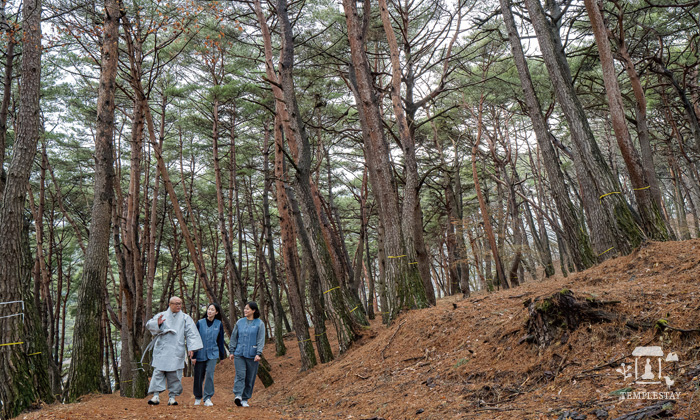
March is just around the corner.
They say spring is coming, but when will it arrive?
Perhaps because the winter was so long,
I feel impatient and head to Jikjisa Temple even
as the chilly wind still blows. I like temples
because most are located in the mountains.
Moreover, many of Korea's famous mountains and scenic sites are often occupied by temples. Therefore, a road leading to a temple is also a road that leads to famous Korean mountains and propitious sites.
Passing through Jikjisa's Iljumun (One Pillar Gate) and Sacheonwangmun (Gate of Four Heavenly Kings), I came across a large pavilion named Manseru. According to records, it was the most magnificent building in this area during the Joseon Dynasty. A huge ginkgo tree over 1,000 years old used to stand in front of Manseru Pavilion, but it—along with the old Manseru Pavilion—was destroyed in a fire at the end of the Joseon Dynasty.
One anecdote passed down at Jikjisa Temple concerns an event that occurred during the reign of Joseon's King Myeongjong. One day, Master Sinmuk—then abbot of Jikjisa Temple—had a dream, in which he saw a yellow dragon curled up under a ginkgo tree in front of Manseru Pavilion. Startled awake and thinking the dream unusual, Master Sinmuk went out to check. Indeed, there was a child sleeping under the tree. The master took the child in, made him a monk, taught him the Buddha-dharma, and helped him pass the state examination for Buddhist monks. The child later became Great Master Samyeong, who saved the country and people during the Japanese invasions of Korea. Master Samyeong's actual hometown is Miryang, Gyeongsangnam-do, but his hometown as a monk can be said to be Jikjisa Temple.
As I passed Manseru Pavilion and stood in the courtyard of Daeungjeon, the main buddha hall, in one glance I had a panoramic view of Mt. Hwanggaksan and the temple. Mt. Hwangaksan, located in the middle of the Sobaek Mountain Range, is a fairly wide mountain. Its wide ridges were still snowy white far up the mountain, as if warning climbers not to be too hasty to climb it.
“Was I being too hasty?”
After giving up my heightened expectations, I visited Daeungjeon Hall, after which I headed to Cheonbuljeon (Hall of 1,000 Buddhas). Plum trees began to open the red buds profusely on the sunny hill behind Gwaneumjeon (Avalokiteshvara Hall).
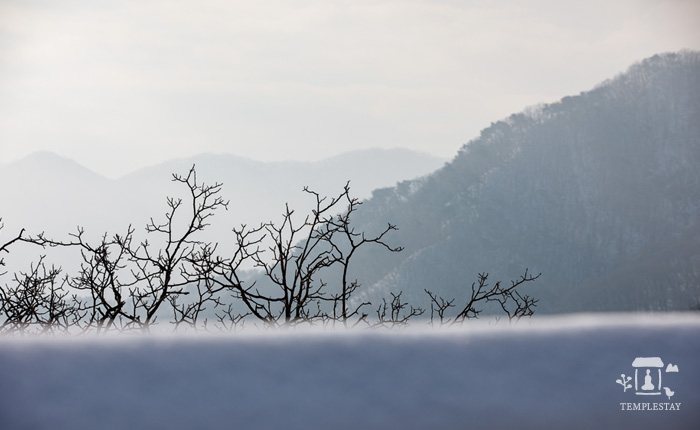
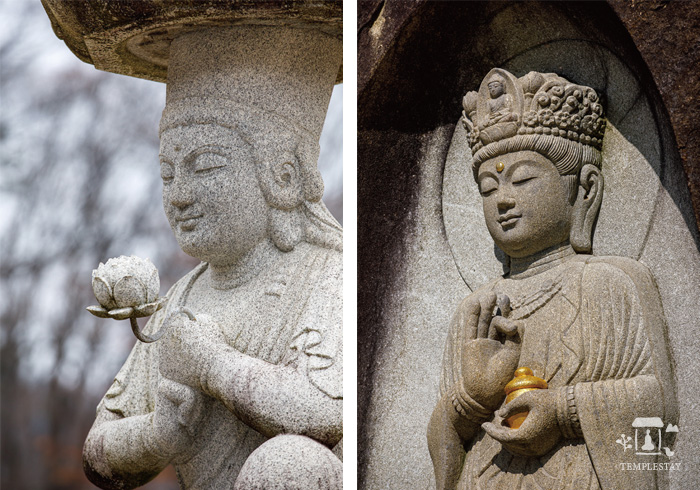
Spring is here. With a happy heart, I approached the flower buds, as pouty as a child's lips, and just admired them for a while.
“Yes, it's already spring, so let's not wince at the thought of winter's cold.”
Now that spring was here, it was time to enjoy it. I suddenly wanted to walk. Should I walk the Meditation Path of Master Samyeong? Should I walk the Old Road of Unsuam Hermitage that connects all the hermitages on the mountain? Thinking of how much time I had to walk, I chose the shortest route.
As I turned to the right of Daeungjeon Hall, I entered a pine forest full of beautiful, tall, majestic pines.
Didn't someone once say, “It is only when the cold winter comes that we are certain pines and nut pines don't wither easily?” Their steadfast spirit ignores the cold and makes me think of Master Samyeong.
The path between the pines was well-maintained and easy to walk. I followed it to Taebong Peak.
Anyone could see that it was a propitious place with mountains surrounding it in all directions like lotus flowers. In the past, this peak once enshrined an earthenware jar holding the placenta of Joseon's King Jeongjong.
“Is the power that once ruled the world collapsing like this?”
Several stylobate stones scattered here and there are evidence of the impermanence of all things.
Even though I slowly caught my breath and carefully walked down the slope, it took less than 20 minutes.
Perhaps because I enjoyed the scenery more than I expected, I was disappointed for my hike to end.
Moreover, although the view of the mountains from a distance is nice, it is not as good as getting in touch with their inner heart. I then decided to walk to a nearby hermitage.
The old road leading to the mountain hermitage begins west of Cheonbuljeon Hall. The path leading up the mountain along the stream that flows around Geungnakjeon (Paradise Hall) is the path to the hermitage. The entrance was quite wide enough for two or three people to walk side by side. After walking for a while and admiring the foamy white rapids flowing over the black rocks, I found a pool of water about as big as a large bathhouse.
It is called Yongso because dragons are said to live here, probably attracted by the clear blue water, but the name “Yongso” seems a bit pretentious. If dragons could live in a pond this size, you could find dragons anywhere in the world. I started a mental argument with whoever gave it that name and hurried on my way.
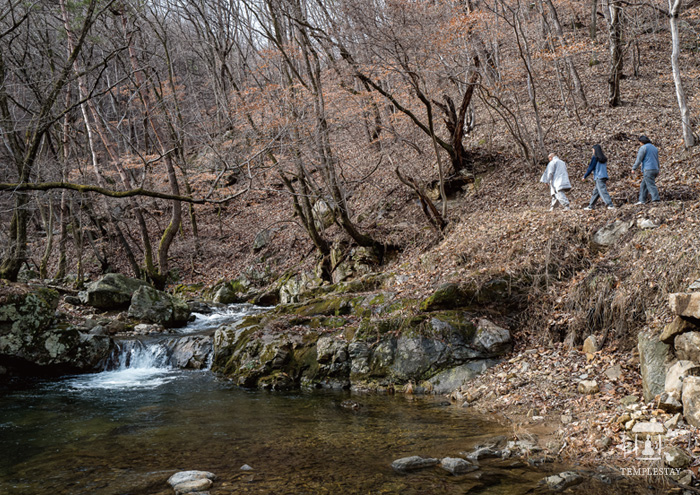
Yongso is the point where two valleys meet. On the left is Neungyeo Valley leading to Neungyeoam Hermitage, and on the right is Unsu Valley leading to Unsuam Hermitage. Neungyeo Valley is rocky and the stream's current is fast. On the other hand, Unsu Valley has a gentle current flowing over fertile soil.
If it was summer, I might have chosen to hike up Neungyeo Valley, but in spring, the beautiful Unsu Valley beckoned like a new bride. The Unsu Valley trail—barely wide enough for one person to pass—is a little-known path that only Templestay participants know about. It is frequented by Buddhist monks during the biannual retreat seasons.
“Tok, tok, tok…”
Somewhere in the forest, a woodpecker appeared to be pecking at the rotten trunk of an oak tree. I stopped walking, looked around to find the source of the sound, and saw a roe deer on the mountainside.
It must have been surprised too, staring at me blankly, and then quickly running away. The sight was so funny that I laughed out loud, disturbing the silence of the forest.
I slowed down my pace further. If I had wanted a fast hike, I wouldn't have chosen this route. It's weird. The slower I walked, the more my eyes watched the ground. I suddenly wondered, “Where am I going?”
The road presupposes one has a destination. One's purpose determines the value of the path. For those who believe that happiness lies in the destination, speed and convenience determine what is a good route. But we have to look back sometime. If we only focus on the destination, the time we spend on the road loses value.
Life is a long journey, and one's lifetime is the time one has walked. For your life to be beautiful, the way you live must be beautiful, and for your life to be happy, the time you live must be happy. In order to experience such beauty and happiness, wouldn't it be better to choose a slow and winding road rather than a fast, convenient one?
I suddenly admired myself for having chosen this path.
When I looked up and tried to suppress the smile spreading slowly across my face, I saw a stream I had to cross. I slowly crossed it stepping on stones, although I could have easily just jumped across.
As I tramped among the pines interspersed with maple trees, a tall imposing pavilion came into view. Seohangnu Pavilion—meaning a pavilion upon which cranes perch—is stylish, and the couplet written on one of its pillars was in a distinct, unique style.
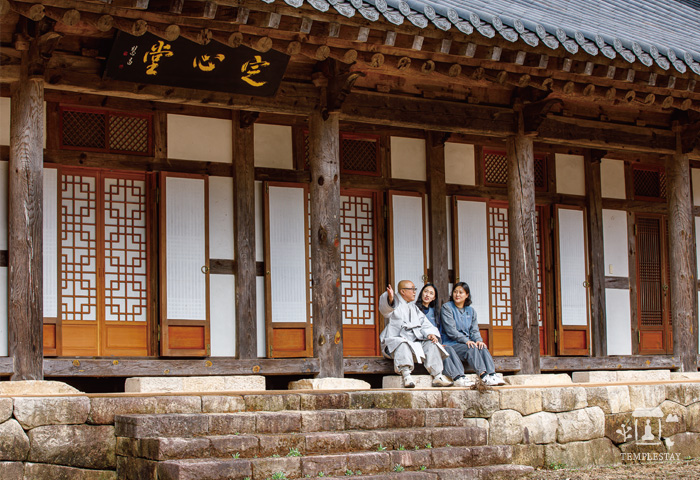
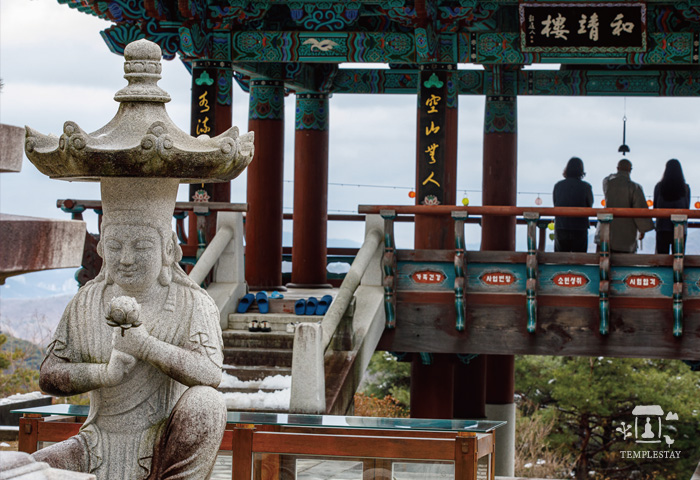
No one is on the empty mountain.
The water flows and flowers bloom
Upon ascending the pavilion, I saw Mt. Geumosan in the distance to the east. It is often called Mt. Wabulsan (lit. “Reclining Buddha Mountain”) because it looks like the Buddha lying down. Myeongjeogam is a hermitage rebuilt by Great Lineage Master Yeongheo Nogwon on the old temple site where once only column foundation stones remained. The master passed away while residing there. He was the one who reconstructed Jikjisa Temple into its present size.
During the Joseon Dynasty and the Japanese colonial period, support for the temple as well as its number of devotees had declined. During those difficult times Master Nogwon rebuilt this large temple with his bare hands, a testament to the amazing power of the vow he made.
I felt like I had walked quite a bit, but my body and mind felt at peace, so I headed to Jungam Hermitage. Perhaps because it is the highest hermitage on this mountain, the wind blowing in my face was cold. The winter scenery was dreary, with only broad-leaved trees on both sides of the road leading upward. I grumbled to myself for no reason.
I thought, “It would be better if the pine forest was denser.”
Jungam is a hermitage Great Lineage Master Gwaneung Jian rebuilt on an old temple site and where he later passed away while residing there. He came to be a symbol of the Korean Seon School that combined Seon and doctrinal Buddhism, and was a sage who “lived like a crane.” He observed the precepts scrupulously and was of noble character. On the left side of the hermitage is an octagonal pavilion which he often climbed to the top of. A verse by Master Hwanseong Jian hanging on the pillar caught my eye.
A friend visits this thatched hut.
The moon is bright, and the wind clear.
The bright moon and clear wind were always with him, so I presume he wasn't lonely at all. He entered nirvana well past the age of 90, and I often wonder how he felt in his later years? A verse by Master Hamwol Haewon hung next to the first one and seemed to provide an answer.
What have you possessed all your life?
A gourd hanging on the wall.
After wandering around the pavilion a while, I turned and began to descend.
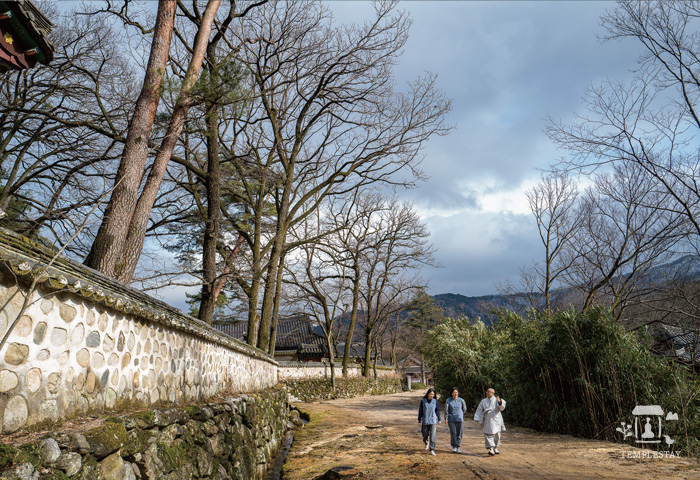
On the way down, I looked back and realized that the path I walked today had been trod by others since olden times. I could say that I made my own choices at the crossroads, but in fact, it is a path others have already walked. Jikjisa Temple has been on this mountain for 1,600 years. How could that have been possible without any internal stability and without anyone who walked the path following the temple's predecessors?
My face got hot as I remembered how I disputed the idea that dragons lived in a pond of the size of a bathhouse, calling the myth pretentious, and judged it to be just another common forest full of broad-leaved trees. Suddenly, the first sentences of Ode to My Humble Adobe came to mind.
It matters not how high the mountain stands.
If an immortal dwells within, it is eminent.
It matters not how deep the river runs.
If a dragon swims within, it is divine.
The path to the hermitage is lined with large broad-leaved trees. When spring matures, this path will be filled with pastel green, and colorful flowers will bloom along the stream.
Seong Jae-heon served as a sutra translator at the Dongguk Institute of the Tripitaka and is currently working as a member of the translation committee for the Collected Works of Korean Buddhism. He participated as a member of the Jogye Order's writing committee for Life of the Buddha and Introduction to Buddhism for Youth. His books published in Korean include Coffee and Dharma and People Who Have Met the Buddha.
Jikjisa Temple
+82-54-429-1700~4
http://www.jikjisa.or.kr





